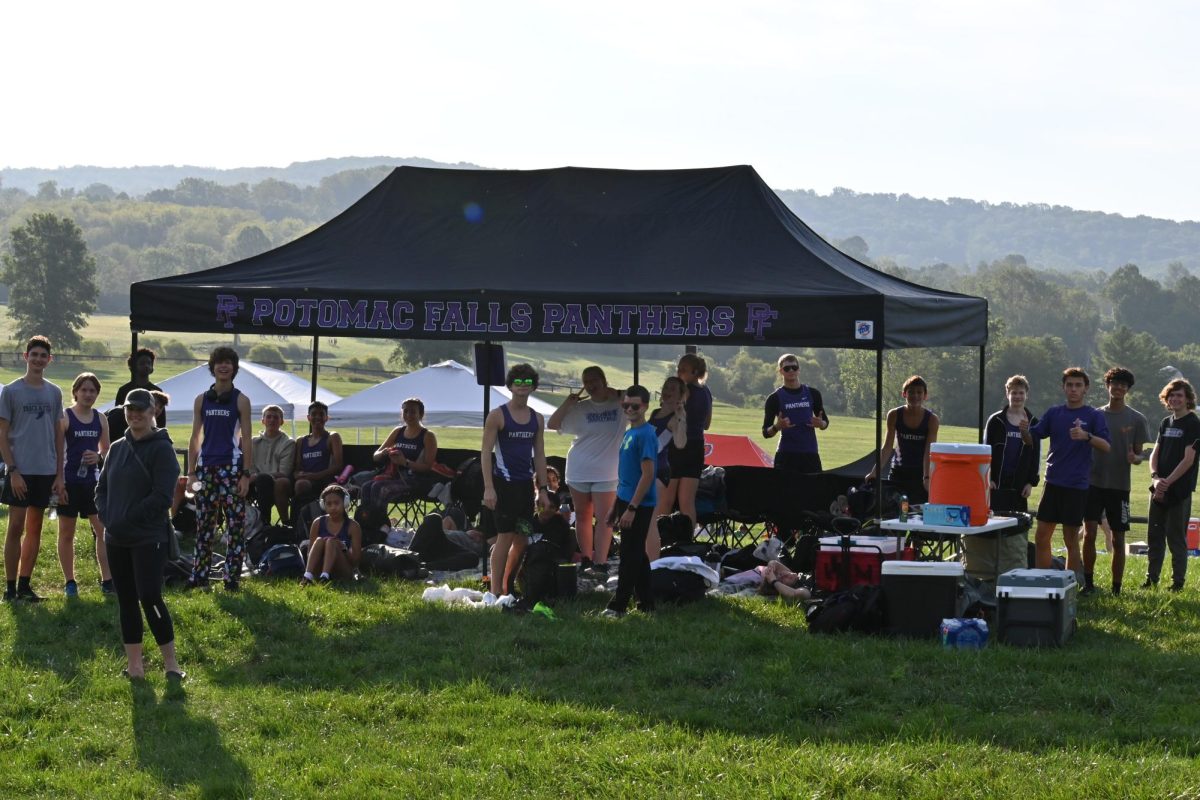How do injuries impact runners and what steps are being taken on the Potomac Falls cross country to prevent them from becoming major setbacks?
No one is safe. That is, no athlete on the Potomac Falls cross country team is completely safe from the possibility of getting injured, largely due to the vigorous nature of the sport.
However, on a team working to improve and make a name for itself at Regionals, it is crucial to prevent the injuries that plague the team so that runners can drop time rather than being set back in their running careers. This raises the question of what can be done by the athletes, coaches, and athletic trainer to keep the “purple train” rolling?
Common injuries that threaten the cross country team, and all runners in general, include shin splints, tendonitis, stress fractures, runner’s knee, plantar fasciitis, and much more. The most prominent of these injuries on the Potomac Falls team this season and seasons prior are shin splints and tendonitis.
Sophomore cross country runner Catherine Linn, who is currently recovering from shin splints, stated, “It can be a bit frustrating when I’m trying to get better and I keep getting set back, and I’m just worrying about my progress and how many minutes I’ve gained for my [5k] time.”
Shin splints are common among cross country athletes at PFHS. This condition consists of pain and inflammation in the tibia, more commonly known as the shin bone, and the muscles and connective tissues around it, according to the Cleveland Clinic. Shin splints are an overuse injury often related to the repeated slamming of the foot onto the ground in distance running.
Damian Pulos, the Potomac Falls athletic trainer more commonly known as Mr. P, states that shin splints and other overuse injuries are more likely to occur on high school cross country teams when athletes are not properly conditioned to run the long distances the sport requires.
Depending on the severity of shin splints, they can be easily treated with rest, ice, stretches, and exercises within a couple of weeks. On the other side of the spectrum, shin splints can last for months on end and even turn into stress fractures of the tibia if left untreated.
“I ice my shins sometimes, and I do cross training. It helps a lot to strengthen the muscles,” said Linn.
Tendonitis, another common overuse injury in PFHS runners, is the inflammation of a tendon that leads to pain and immobility. This condition can be short or long term, and if left untreated, can lead to a rupture of the tendon.
Ciadan England, a senior on the varsity cross country team, is suffering from tendonitis in her knee at the moment.
When asked about what she is doing to recover, England said “I went to Mr. P and he gave me some calf stretches and then also, Coach Kalka gave me some calf strengthening exercises.” She said this injury affects her running because she is “definitely slower” than she should be.
Coach Lisa Johnston, who has had her fair share of injuries throughout her career as a marathon runner, explains that injury is so common in distance runners because of overtraining. “Usually they increase their mileage too quickly and it’s too much force on the bones and joints,” said Johnston.
With overuse and overtraining being the primary culprits behind injuries in PFHS runners, the weekly training plan developed by the coaches that determines the intensity and mileage of daily practice runs is a key factor in the prevention (and development) of injuries.
“One of the most important things with preventing injuries is to build up gradually,” said Coach Matt Celsa, a Potomac Falls cross country and track alumnus.
“What we do is we have different running groups … a group that does a small amount of running, a group that does a moderate amount of running, and a group that does a lot more running. We split people into those groups based on their ability level and the amount of training that they’ve done,” said Celsa.
The team also has cross training days. “We have days where athletes do not run, or where they simply walk, lift weights, or do an alternate activity. That is to help them recover from running and other activities but also improve their strength in other areas, like the lower body or upper body strength,” Celsa said.
Pulos also said that it is important to strengthen and stretch the lower body muscles as a way to prevent overuse injuries.
Celsa went on to specifically say that the coaching staff has been extra focused on reducing injuries on the girls team, as a lack of injury-free female runners was a prevalent issue last season.
Despite the large number of injuries in PFHS cross country, there are a lucky few runners who have managed to stay healthy throughout their time on the team. One of these athletes, Zack Himmelberger, a junior on the varsity boys team, runs an average of 40 miles per week, give or take. So what is the secret to staying uninjured with this high weekly mileage?
When asked what he does to prevent injury, Himmelberger said, “It’s mainly about consistency. Obviously freshman year we weren’t doing 40, we were doing 20 or 30 [miles per week]. As you keep going in the sport, you go more miles. Next year I’ll probably do 50.”
Additionally, Himmelberger said that if he feels like he is on the verge of getting injured, he will take some time off of running.
As for the outlook for this season, things are looking up according to Celsa, who said, “We are doing better than last year.” Mr. P confirmed this when he said he has seen a decrease in running injuries over the past few years. Celsa said that the coaching staff intends to continue to reduce injuries by “trying to be more proactive in preventing injuries, talking to the athletes, adding more cross training if it’s needed, and talking about conditioning during the summer.”


